The Three Pyramids Spread
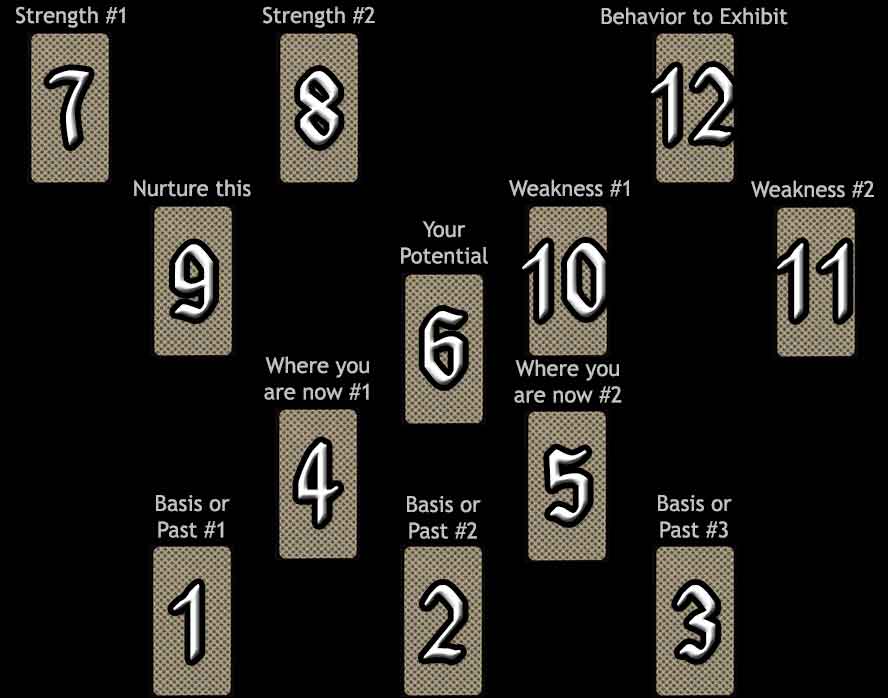
Difficulty: Complicated
Basically, there is the main pyramid in the centre, and two smaller pyramids on each side. One is inverted.
Positions 1 & 3 represent where the reader comes from, or what has made them/shaped them on the various levels. Can be from environment, upbringing, schooling, etc. A look at the past, but with more objectivity than is usually given when using tarot cards.
Positions 4 & 5 represent who the reader is right now. May or may not make pleasant reading, but hey, this is what this is about, right?
Position 6 represents who the reader could be. Again, it might or might not look good, but a person can learn from that and change who they are accordingly. (This is a bit like how Scrooge did things in 'A Christmas Carol'.)
Positions 7 & 8 are the reader's strengths. This is the light they have, which can be bought to the forefront. What carries the person should not be hidden or unacknowledged.
Position 9 represents what should be given to oneself or created within.
Position 10 & 11 represent personal areas for development or weaknesses. Again, might not make good reading, but if someone looks at their strengths first, they will be able to see a balance is there and can choose to focus on one side or the other. This is where a person could really see how their shadow side comes into play.
Position 12 represents what the reader should be offering externally, or what they can bring to their world or to others who inhabit that world.
Your Three Pyramids Reading
Strength #1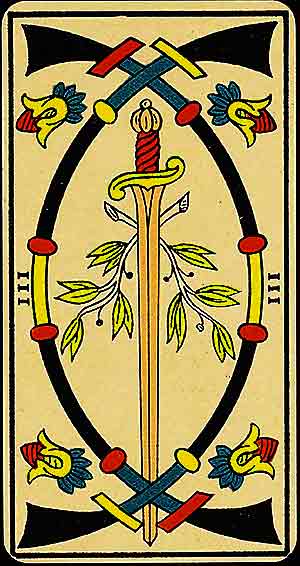 |
Strength #2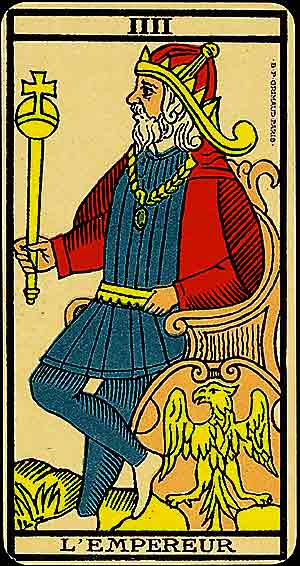 |
 |
Exhibit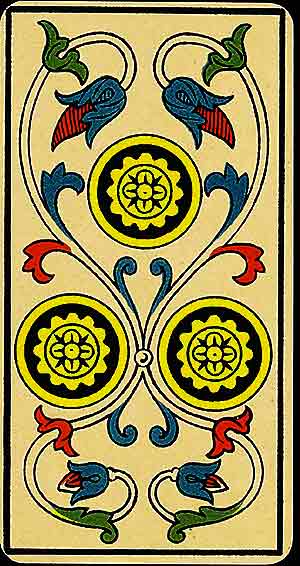 |
|||
Nurture This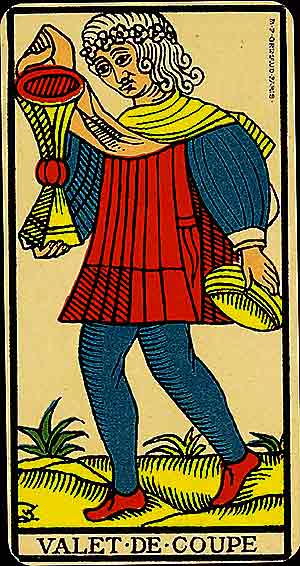 |
Potential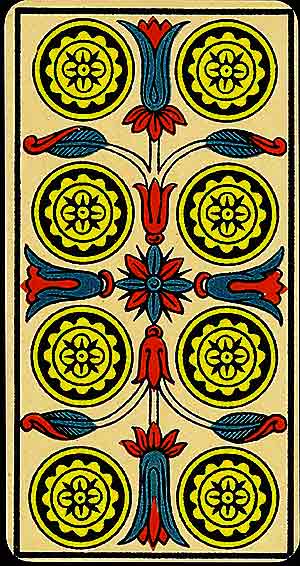 |
Infirmity #1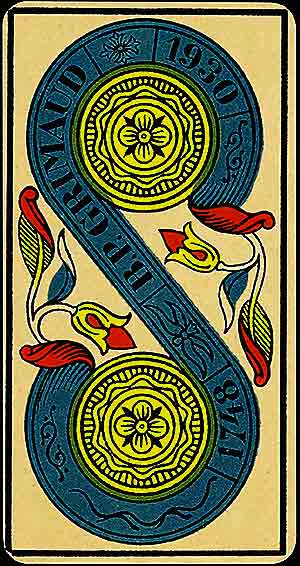 |
Infirmity #2 |
|||
Now #1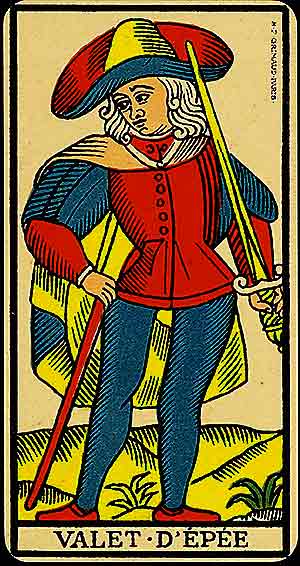 |
Now #2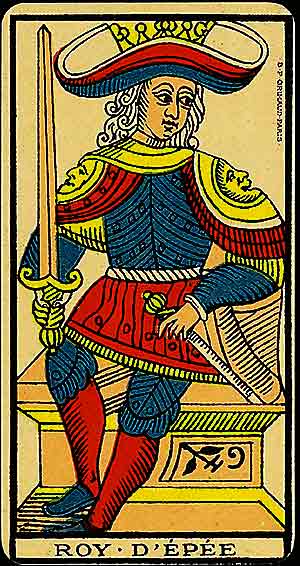 |
|||||
Base (past) #1 |
Base (past) #2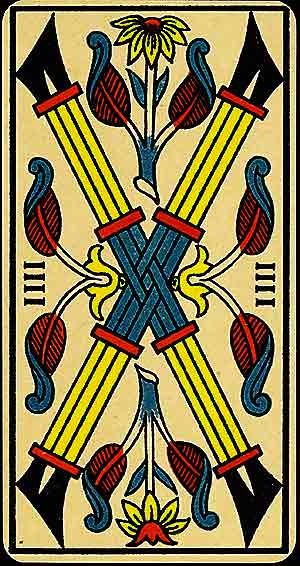 |
Base (past) #3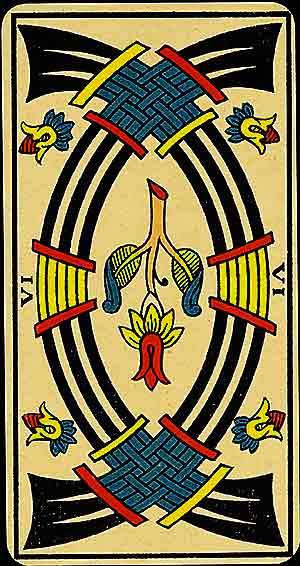 |
1: Base #1

Symbolism:
Four swords are arranged symmetrically, often forming a square or cross-like pattern, symbolising rest and reflection. The imagery suggests a pause for recuperation, stability, and the need for introspection before moving forward.
Meaning:
The Four of Swords symbolises the need for rest, reflection, and recovery. It encourages taking time to recharge after challenges and to prepare for future endeavours. This card highlights the importance of mental clarity through stillness.
In relationships, it may indicate a pause or need for space. Spiritually, it represents retreating into contemplation to find peace.
Keywords:
Rest, recovery, introspection, stillness, clarity, pause, preparation, healing, reflection, mental rejuvenation.
2: Base #2

Symbolism:
Four batons form a stable, rectangular frame adorned with budding leaves, signifying balance and structure. This card represents a foundation of support and a sense of accomplishment in one's endeavours.
Meaning:
The Four of Batons represents celebration, stability, and harmony. It marks a time to pause and appreciate achievements or milestones. This card often symbolises community, shared joy, and the fulfilment of goals.
In relationships, it indicates harmony, commitment, or joyful gatherings. Spiritually, it reflects alignment with your surroundings and a sense of belonging.
Keywords:
Celebration, harmony, stability, joy, milestones, unity, achievement, community, gratitude, fulfilment.
3: Base #3

Symbolism:
Six swords are symmetrically aligned, creating a sense of motion and balance, often softened by decorative flourishes. The card symbolises transition, progress, and moving away from difficulties toward calmer waters.
Meaning:
The Six of Swords represents transition, recovery, and moving away from difficulties. It signifies a journey—physical, emotional, or mental—toward calmer circumstances. This card encourages leaving behind what no longer serves you.
In relationships, it may indicate healing and moving on together or apart. Spiritually, it reflects the process of releasing burdens for personal growth.
Keywords:
Transition, recovery, moving on, healing, journey, progress, leaving difficulties, calm, relief, personal growth.
4: Where you are now #1

Symbolism:
The Valet of Swords is shown standing confidently, holding a sword upright or at an angle, symbolising readiness and curiosity. The figure's alert posture reflects themes of observation, intellect, and the early stages of mastering mental or communicative skills.
Meaning:
The Valet of Swords symbolises intellectual curiosity, observation, and new ideas. It encourages exploring knowledge and being open to learning. However, it also warns of hasty communication or judgment.
In relationships, it suggests a need for honest dialogue or the exploration of new dynamics. Spiritually, it represents the first steps toward understanding profound truths.
Keywords:
Curiosity, observation, new ideas, communication, learning, honesty, vigilance, intellect, youthful energy, exploration.
5: Where you are now #2

Symbolism:
The Roy of Swords sits on a grand throne, gripping a sword with authority, surrounded by minimal decoration to emphasise his focus and intellect. This card represents mastery of logic, clear judgment, and leadership in matters requiring mental precision and fairness.
Meaning:
The King of Swords represents authority, logic, and ethical leadership. He advises using intellect and fairness to make decisions. This card encourages seeking truth and upholding moral integrity.
In relationships, it suggests rational communication and mutual respect. Spiritually, it represents mastery of the mind and the power of clear thought.
Keywords:
Authority, logic, truth, judgment, fairness, intellect, leadership, integrity, clarity, rationality.
6: Your potential

Symbolism:
Eight coins form a structured, methodical arrangement, often decorated with symmetrical flourishes, symbolising diligence and skill. The imagery suggests focused effort, mastery, and dedication to refining one's craft.
Meaning:
The Eight of Coins represents hard work, diligence, and skill development. It reflects a period of focused effort where progress is made through consistent attention to detail. This card encourages honing one's craft, perfecting skills, and continuing to learn and grow, even if the rewards seem distant.
In relationships, it may indicate the need to put in the effort to build a lasting connection. Spiritually, it speaks to dedication and continuous improvement, emphasising that mastery is achieved through commitment and practice.
Keywords:
Hard work, skill, dedication, mastery, craft, focus, attention to detail, improvement, practice, perseverance.
7: Strength #1

Symbolism:
Three swords intersect, forming a dynamic triangular arrangement, often accompanied by minimal decoration. This design represents conflict, heartache, or the challenging growth that follows emotional or mental pain.
Meaning:
The Three of Swords signifies heartache, betrayal, or grief. It is a card of emotional pain but also serves as a reminder of the healing and growth that follow. This card encourages you to confront and process your pain to move forward.
In relationships, it reflects loss, separation, or betrayal. Spiritually, it emphasises the transformative power of overcoming emotional trials.
Keywords:
Heartbreak, sorrow, betrayal, grief, emotional pain, healing, loss, separation, growth, transformation.
8: Strength #2

(L'Empereur)
Symbolism:
The Emperor sits firmly on a throne adorned with symbols of strength and authority. His scepter and orb signify dominion over the material world, while his armour beneath the robes suggests readiness to defend his position. The rocky landscape at his feet symbolises stability and enduring power.
Meaning:
The Emperor represents structure, discipline, and the establishment of order. He embodies the qualities of leadership and protection, encouraging you to take charge of your circumstances with clarity and determination. This card often points to the need for planning, responsibility, and stability.
In relationships, the Emperor stresses respect, loyalty, and shared goals. Spiritually, he reminds you that boundaries and structure are essential for growth.
Keywords:
Authority, structure, discipline, stability, leadership, protection, responsibility, planning, boundaries, foundation.
9: Nurture this

Symbolism:
The Valet of Cups holds a cup, gazing into it with a reflective or curious expression, symbolising emotional openness and creative potential. The youthful figure represents the exploration of feelings, intuition, and the first steps toward emotional or artistic growth.
Meaning:
The Valet of Cups symbolises youthful creativity, emotional openness, and new beginnings in relationships or artistic endeavours. It suggests a message of love or the need to embrace your inner child's wonder and imagination.
In relationships, it reflects new connections or a renewal of emotional bonds. Spiritually, it invites you to remain receptive to intuitive insights and creative inspiration.
Keywords:
Creativity, inspiration, emotional openness, curiosity, new beginnings, playfulness, imagination, intuition, messages, artistic exploration.
10: Weakness #1

Symbolism:
Two coins are positioned symmetrically, often linked by a ribbon or floral decoration, suggesting balance and flow. The design reflects themes of adaptability, resource management, and the harmonious juggling of priorities.
Meaning:
The Two of Coins symbolises balance and adaptability. It speaks to juggling multiple priorities or resources, and the ability to maintain equilibrium in a time of change. This card encourages flexibility in managing material or financial matters, as well as maintaining a healthy balance between work and personal life.
In relationships, it may indicate the need for balance between personal and professional responsibilities. Spiritually, it represents the flow of energy and learning how to maintain harmony amid life's challenges.
Keywords:
Balance, adaptability, flexibility, duality, priorities, change, harmony, juggling, management, resourcefulness.
11: Weakness #2

Symbolism:
Six cups are symmetrically aligned, interwoven with flourishing leaves or flowers, signifying nostalgia and harmonious emotions. The imagery suggests a return to past joys, innocence, or the exchange of heartfelt kindness.
Meaning:
The Six of Cups symbolises nostalgia, innocence, and the joy of revisiting the past. It reflects happy memories, generosity, and the simplicity of pure emotional connections. This card encourages embracing the wisdom of your past while staying present.
In relationships, it may suggest a bond rooted in history or the rekindling of old connections. Spiritually, it calls for a return to childlike wonder and openness.
Keywords:
Nostalgia, innocence, joy, generosity, childhood, memories, emotional connection, simplicity, kindness, openness.
12: Behavior to exhibit

Symbolism:
Three coins are arranged in a triangular pattern, accompanied by simple yet elegant ornamentation, symbolising craftsmanship and collaboration. This card evokes themes of skilful creation, teamwork, and steady progress.
Meaning:
The Three of Coins reflects teamwork, mastery, and collaboration. It highlights the importance of working with others toward a common goal, whether in a creative, financial, or professional endeavour. This card speaks to the satisfaction of seeing one's work valued and appreciated, and it encourages developing one's skills in a collective environment.
In relationships, it indicates a partnership where both individuals contribute their strengths. Spiritually, it represents the process of refining one's craft and the rewards of effort through cooperation.
Keywords:
Teamwork, collaboration, craftsmanship, recognition, mastery, dedication, effort, skill, partnership, accomplishment.
